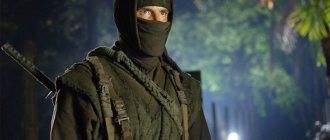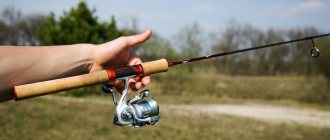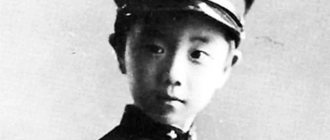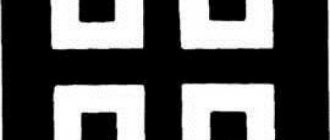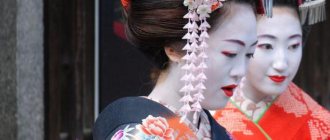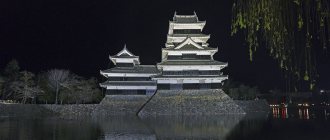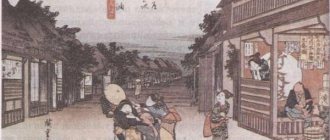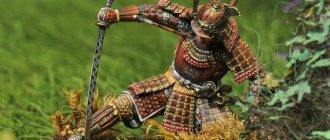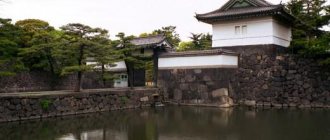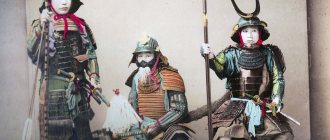Learn about ninjas at the Iga School Ninja Museum
The Iga School Ninja Museum is located in Ueno Park (Ueno Castle Park in Iga), a five-minute walk from Uenoshi Station on the Iga-tetsudo train line. In it you can see a ninja estate, try the art of ninja yourself in the “Ninja Training Hall”, get acquainted with the legends in the “Hall of Ninja Traditions”; and the area outside regularly hosts ninja shows.
Signs with explanations for tourists in English, French, Italian, German and Japanese
The ninja manor looks like a completely ordinary farmhouse with a thatched roof, but there are ingenious mechanisms hidden in it. The guide, dressed as a ninja, explains: “The mechanisms play a role similar to current security systems. In Iga, every house had such devices in two or three places.”
Ninja Manor (top left); rotating panel allowing you to quickly hide (top right and bottom right)
In the Ninja Training Hall you can learn about the equipment and history of the ninja. There are more than 400 exhibits, including ninja shurikens made from recorded records, mizukumo artifacts said to have actually been used, and much more. Shurikens most likely were not used in real combat. The guide says that samurai fought, and ninjas specialized in methods that allowed them to escape and hide.
Replicas of shurikens (top left); mizukumo access, which allowed movement on water (top right); a sai scabbard and a shinobigatana sword with a special cord-tied hilt (bottom left); ninja clothes (bottom right)
The “Hall of Ninja Traditions,” which presents the history and way of life of the ninja, displays clothing and everyday items. It is very interesting to learn about the wisdom that ninjas knew. There is also a corner for children where they can answer ninja-related questions, as well as a souvenir shop.
A sword is hidden under the floorboards in the ninja manor
- Opening hours: 9:00-17:00 (entrance until 16:30)
- Admission: 756 yen (high school students and adults), 432 yen (children 4 to 15 years old)
- Address: Mie-ken Iga-shi Ueno Marunouchi 117
- Weekends from December 29 to January 1
Related article: Ninja: fiction and reality
Be a ninja in the Koga Ninjutsu Village
On the vast territory of the Koga Ninjutsu Village, located at the foot of Mount Suzuka, there is a Ninjutsu Museum, a ninja estate equipped with various devices, and a hall for training in shuriken throwing. At the ninja training ground, you can learn nine ninja skills, including climbing stone walls, climbing fences, and walking along walls on narrow ledges.
When climbing over fences, the ninja sword is used as a ladder. There is a long cord on it, by which you can then pull the sword towards you
The ninja manor previously belonged to the Fujibayashi family, descendants of the Koga ninja, and was moved here. Like the Iga Ninja Manor, it has a secret exit and various mechanisms.
At the shuriken throwing training area, you can try throwing them. In the background is the Fujibayashi ninja estate that was transported here.
Kitazawa Akira, who works at the Ninja Village, explains: “This is a strategically important place through which communication routes passed, and it was often fought over for its possession. None of those who competed for it were able to establish themselves here, and an organization of self-government based on a strong spirit of collectivism developed here.”
The village of Koga also used rotating panels
The Ninjutsu Museum contains historical sources and ninja equipment, including the essay “Ten Thousand Rivers Flow into the Sea” (Mansen Shukai). Kitazawa Akira says that such books were in every home, but nothing particularly valuable was said in them, since ninjutsu was a secret art in which valuable skills were transmitted orally.
Exhibition of the Ninjutsu Museum (top left); the museum displays shuriken and makibishi (above right); essay on ninjutsu “Ten thousand rivers flow into the sea” (Mansen shukai) (below)
- Address: Shiga-ken Koga-shi Koka-cho Oki 394
- Opening hours: 9:00-17:00 (entrance until 16:30)
- Admission: 1030 yen (high school students and adults), 820 yen (middle school students), 730 yen (junior students), 520 yen (preschoolers)
- Opening hours and holidays vary depending on the season, please check the official website before visiting
Koga-ryu ninjutsu Ryutaro Ikeda
Chapter 1
A Brief History of Ninjutsu
In this chapter we will only briefly consider the main points of the history of ninjutsu, since in order to write a detailed history of this art, a multi-volume study would be required. The roots of this art go back to ancient times, to times about which we cannot judge unambiguously, because in sources that have survived to this day, for example in the Kojiki (Records of Ancient Acts), in the Nihon Shoki ( Annals of Japan") or in the ancient Chinese chronicle "Shi Ji" ("Historical Notes"), the historical narrative is very closely intertwined with folklore fiction and religious mythology. However, in those distant times there were only numerous prerequisites for the formation and further development of this art; ninjutsu itself appeared, it seems, no earlier than the era of Namboku-cho (1336-1392) or Muromachi (1392-1573), when such schools as Katori Shinto-ryu, Kashima Shinto-ryu and Nen-ryu, which had a huge influence on the development of Japanese bujutsu. If we take other martial arts such as kenjutsu, sojutsu, or jujutsu, despite the legends about their origin in the “Age of the Gods,” their real history can be traced back to the 14th century. The same applies to ninjutsu: in the Namboku-cho era, the earliest reliable sources mentioning the deeds of shinobi no mono were compiled, but legends claim that there were shinobi already in the time of Emperor Jimmu. It should be noted here that the term “shinobi” itself is somewhat ambiguous. Today, by the word “shinobi” we mean a person who has been trained in shinobi no jutsu, i.e. trained to secretly penetrate heavily guarded castles, disguise himself as a traveling monk or merchant, and conduct conversations with both ordinary people and important dignitaries in such a way as to extract valuable information from the conversation. In the distant past, such as the Asuka period (538-710) or the Nara period (710-794), the word "shinobi" could simply mean a person who does something in secret. The word “shinobi” could also mean a spy, but more often its synonyms were used: “kancho”, “chōja”, etc., and we cannot know for sure whether these kancho and chōja were simple warriors or specialists in secret penetration . In the Kojiki we can see a description of the military tricks that ancient heroes used, but I think it would be wrong to call any trick and any manifestation of ingenuity ninja tactics.
For example, it is known that during the eastern campaign, Emperor Jimmu Tenno had a vision in a dream in which he was told to take clay from Mount Ama no Kaguyama, make ritual vessels from it and dedicate them to the gods. For this he was promised victory over the hostile Emisi tribes. But Mount Ama no Kaguyama was located in territory occupied by the enemy. Therefore, it was necessary to come up with some kind of trick to come to this mountain undetected by the enemies and collect clay. This task was completed by Shinetsuhiko and Otoukashi, who, disguised as an old man and an old woman, penetrated the mountain, easily bypassing the enemy outpost, collected the required amount of clay, and returned back.
Also in the “Kojiki” and “Nihon Shoki” it is said that when Prince Yamato-Takeru conquered the island of Kyushu, he, disguised as a girl, entered the dugout of the leaders of the Kumaso tribe, and at a festive feast stabbed them with a sword. Here we see an example of camouflage to deceive the enemy. But we cannot say that ninjutsu was used here, since it is clear that this trick of changing clothes was simply a manifestation of resourcefulness, and not the use of some kind of system of tricks.
It seems that the ninja themselves believed in the divine origin of their art. The Treatise “Koga-ryu ninpo densho” (“Written instruction on ninpo of the Koga-ryu school”) says the following about the origin of ninjutsu:
“The art of shinobi was transmitted by the [Shinto] gods Oomunamumi no Mikoto and Sukunahiko no Mikoyo in the “Age of the Gods.” After this, records were compiled about this art, which were kept in the imperial palace, called Kumoshibari and Kumaso-jimi. During the rebellion of Soga no Emiji, many manuscripts were lost in the fire. Only a small part of the manuscripts survived, and among the surviving texts were notes on the art of shinobi. These manuscripts were received by Fujiwara Emyoshikasu (706-764). He gave them [for safekeeping] to the Kakuho-ji Monastery in Iga, and [after centuries] they were handed over to the general Kusunoki Masashige and Akutagawa Hyobu, who was a samurai from the imperial palace guard. Later, he went to live in Koga, in Omi Province, and it was from this place that the art of shinobi spread everywhere. This teaching became known as Koga-ryu. From this teaching, some parts were preserved, others were discarded as unnecessary, and only those that contained the essence of the teaching were taken.”
Also, many scrolls on ninjutsu talk about the Chinese origin of this art. Ninja treatises take us back to ancient China at the end of the Xia era (1765 BC). The last ruler of the Xia dynasty, Jie-wang, was an immoral and cruel man. He built luxurious palaces for himself, plundered the treasury and raised taxes, and thereby brought his kingdom to extreme poverty. The whole people, both commoners and princes, rose up against him. The ruler of the region, Shang Cheng-tang, headed the coalition of princes. Already in that ancient era it was impossible to wage a war without preliminary reconnaissance. Cheng-tang had a man named Yi-yin in his service. He was an unusually gifted man, an intelligent, prudent and cunning politician. His figure is assessed ambiguously by historians. Ancient Chinese moralists tried to portray him as a wise courtier and philosopher. Some modern historians call him a clever careerist and usurper, since after the death of Cheng-tan, actual power passed into his hands. One way or another, this man did a lot to overthrow the Xia Dynasty and rise the Shang Dynasty.
Yi-yin
Cheng-tang sent Yiyin to Xia for reconnaissance. In this case, a method was used that, centuries later, would become the classic method of ninjutsu - yamabiko (“mountain echo”). Cheng-tang pretended to have a quarrel with Yi-yin, accused him of all sorts of abuses, and even wanted to kill him with his own hands by shooting him with a bow. Yi-yin, fleeing the wrath of his former patron, fled to Xia under the protection of Tse-wan. Sources are silent about his espionage activities; the Shih Chi says that Yi-yin simply left Cheng-tang and headed to Xia. But three years later, having hated the ruler of Xia, he returned back to Bo (the capital of the Principality of Shang). Mencius even wrote that Cheng-tang recommended Yi-yin to Tse-wang as an adviser, but he rejected him, and therefore Cheng-tang began a war against him. However, the ancient Chinese military theorist Sun Tzu, in his famous book “The Art of War,” mentions Yi-yin in the context of the chapter “The Use of Spies.” True, Sun Tzu calls him Yi Zhi - this is another name for Yi-yin:
“In ancient times, when the Yin kingdom was rising, Yi Zhi was in the Xia kingdom; when the kingdom of Zhou was rising in the kingdom of Yin there was Lü Ya. Therefore, only enlightened sovereigns and wise commanders know how to make people of high intelligence their spies and in this way they certainly accomplish great things.” (Translated by N. I. Conrad)
There are also mentions of I-in in treatises on ninjutsu. The Bansenshukai says about him:
“Since the time of the Yellow Emperor, there have only been a few people who have mastered ninjutsu. During the Yin period, a man called Yi-yin mastered this art and served Prince Tang. He sneaked into the palace of Tse-wan, the ruler of the Xia kingdom, and killed him. In ancient times, the rise of the Yin Dynasty was due to Yiyin serving the Xia Dynasty. He took Jie's side five times, and Tang's side five times, people did not know that Yi-yin served as a spy."
In turn, the fall of the Shang dynasty and the rise of the Zhou dynasty in the 11th century. BC. was also associated with a spy story. The last ruler of Shang, Zhou Xin, followed in the footsteps of Jie-wan and lost the “Mandate of Heaven.” He was overthrown by Wu Wang, who founded the Zhou dynasty. He was helped in this by Jiang Tzu's advisor, also known as Lü Shang, Lü Ya. He was also called simply by the name of his position - Taigong (Chinese: "chief minister"). The Bansenshukai puts it this way:
End of introductory fragment.
